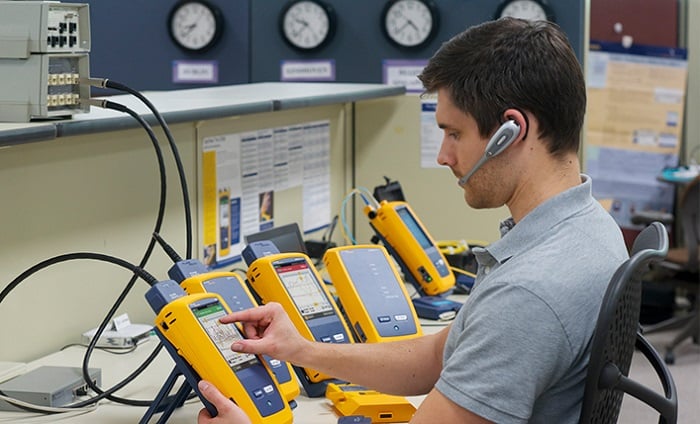WHITE PAPER
Authorized Calibration
Download PDF
Overview
You are serious about your cable test instruments. You own a Fluke Networks Certification Tester, so you expect it to be accurate. You receive an email or a LinkWare notification saying that it is time for your tester’s yearly calibration. At this juncture, you might ask, “Why? These testers don’t have any moving parts to go out of adjustment. How do they calibrate my tester? Do I really have to send it back to Fluke Networks to be calibrated?”
These are completely valid questions, especially since you cannot use your tester when it is out for calibration (unless you have Gold support, in which case you can arrange a free loaner). But, let’s go over some potential situations that might occur without calibration. For example, what if your job requires tight tolerances and accurate measurement, do you want to provide potentially incorrect reports? What if you encounter inconsistent test results between your testers? Calibration can prevent these issues from ever occurring.

On This Page
Why Calibrate?
Organizations that have implemented an ISO 9001 quality management system are required to calibrate all their measuring equipment used to verify or control quality, and all such calibrations are required to be traceable to national or international standards. Calibration dates are also included on test reports, so if there is a dispute regarding your install and your reports show your tester was out of calibration, they will be worthless in arguing your position.
In addition, manufacturers of cabling and connecting hardware issue multi-year product and application warranties only after an audit of test data that has been gathered with instruments with a valid calibration carried out in accordance with the manufacture’s specification and time scales. As a result, receipt of payment for a job is contingent on successful certification of all the links, which often number in the thousands.
The components that make up your tester include resistors, capacitors, and integrated circuits, all of which are stable. However, slight variations can occur over time, due in part to variations in temperature and humidity and conditions in storage and transport. Even in a controlled environment, the circuits within your tester warm up and cool down due to the power draw of the measurement systems as it cycles on and off throughout use. Other events that can affect the components include contamination of the circuit board by outside materials or a traumatic event such as typical bumping a jarring experienced by field test equipment.
Keep in mind that a faulty tester can also play havoc in various ways. For instance, suppose the certification test yields false passes of bad links. In that case, the future users of the system could experience networking problems, traceable to the cable plant. These problems could result in legal action against the installer, who would also be responsible for rework and repair. On the other hand, suppose the tester fails good links. Then the installer will expend needless time and money on repair and rework. Calibration serves to address these situations and ensures that your tester works as well as it did when you used it on day 1.
Your copper or fiber tester will be precisely calibrated to factory specifications using the full battery of proprietary Fluke Networks test procedures and custom equipment, adjusted/repaired as necessary with genuine repair parts, software and firmware updates applied, all accessories tested and replaced if defective, and then cleaned and performance verified.
Why Calibrate with Fluke Networks Authorized Centers?
When your certification tester is calibrated by an authorized Fluke Networks service center, your tester is being calibrated with specialized equipment similar to that used in our factory that is designed to industry specific standards. The tester measures each standard and stores internal correction data so that subsequent measurements of the standard are precisely centered. A comprehensive self-test is also performed which measures against a template, which was created by analyzing all the testers that came before it. This narrows down the chances of error to almost zero. Since we do not share our calibration processes or specialized equipment with non-authorized service centers, we frankly don’t know what they are doing or how they do it. Non-authorized labs may simply calibrate basic measurements such as length or resistance, which doesn’t guarantee that more complex measurements such as NEXT are being performed accurately. Unauthorized centers simply cannot promise the level of accuracy provided by Fluke Service Centers. Calibrate your tester at a Fluke Networks authorized service center and save yourself from frustration.
Why switch to DSX?
Still have a DTX series tester? As of June 2018, Fluke Networks service centers will no longer be able to calibrate any DTX modules or mainframes since the series has been discontinued. Now is the perfect time to upgrade to Versiv. With faster testing times, easy-to-use interface, and robust test results with Linkware Live, Versiv is the industry leader for cabling certification. Upgrading to Versiv also means that you will be ready to take on new jobs from Cat 5 to Cat 8 to Singlemode and Multimode fiber with its modular design. The Versiv cabling certification system is designed to save you money in every phase of the cable testing job and to get to systems acceptance faster. Customers who switch to Versiv report a 2/3 reduction in testing problems and a 10% increase in profitability.
Annual Calibration for Free with Gold Support
Unauthorized centers also do not honor your Gold Support membership and can cost you hundreds if not thousands of dollars. Why lose time and money when your annual calibration is included with Gold Support at no charge? With Gold Support, you are eligible to receive a loaner unit when you send your tester in to an authorized service center. This means you won’t go without a tester and can keep your team working.




